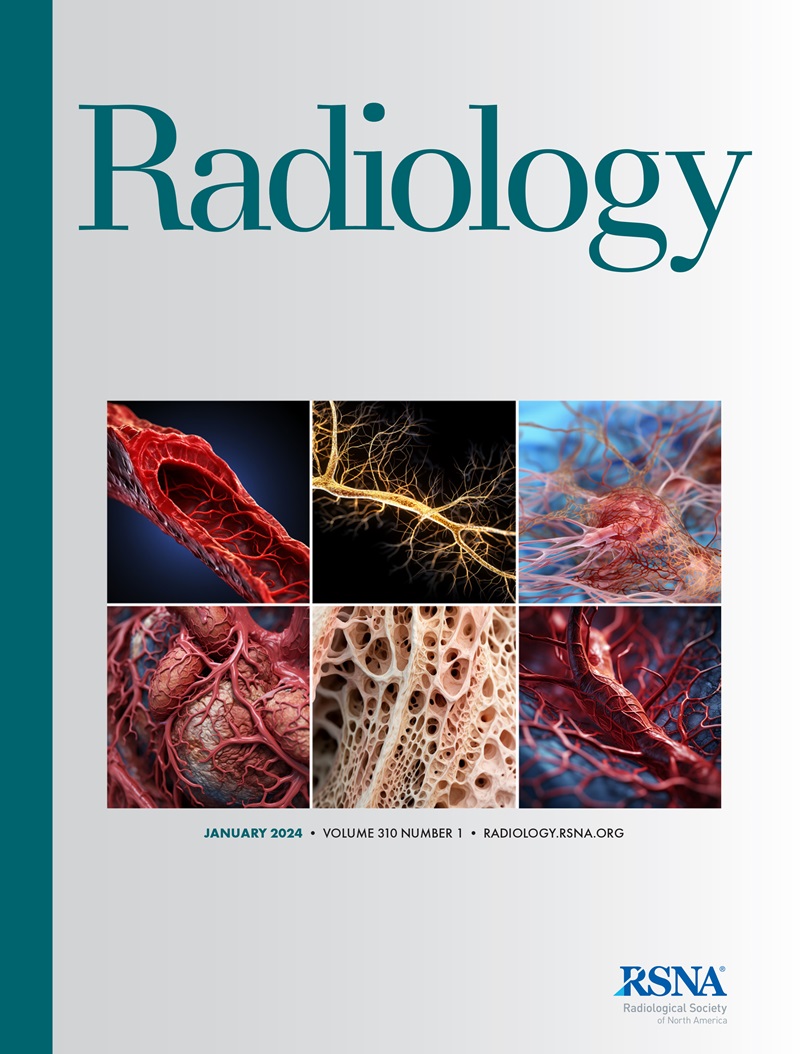Colorectal Cancer and Advanced Adenoma after Single CT Colonography or Biennial FIT Screening in the SAVE Randomized Controlled Trial.
IF 15.2
1区 医学
Q1 RADIOLOGY, NUCLEAR MEDICINE & MEDICAL IMAGING
Donella Puliti, Lapo Sali, Mario Mascalchi, Gianfranco Manneschi, Teresa Intrieri, Adele Caldarella, Beatrice Mallardi, Giovanna Masala, Giuseppe Gorini, Marco Zappa, Paola Mantellini
求助PDF
{"title":"Colorectal Cancer and Advanced Adenoma after Single CT Colonography or Biennial FIT Screening in the SAVE Randomized Controlled Trial.","authors":"Donella Puliti, Lapo Sali, Mario Mascalchi, Gianfranco Manneschi, Teresa Intrieri, Adele Caldarella, Beatrice Mallardi, Giovanna Masala, Giuseppe Gorini, Marco Zappa, Paola Mantellini","doi":"10.1148/radiol.250091","DOIUrl":null,"url":null,"abstract":"<p><p>Background A 5-year screening interval for CT colonography (CTC) and a 2-year screening interval for fecal immunochemical tests (FITs) have been recommended on the basis of the natural history of colorectal cancer (CRC). Purpose To assess whether the recommended 5-year interval for screening CTC is appropriate and whether CTC is associated with earlier diagnosis relative to biennial FIT screening. Materials and Methods This secondary analysis of the SAVE randomized controlled trial was conducted between March 2012 and March 2018; 14 981 participants aged 54-65 years were randomly assigned to groups undergoing a single CTC examination or three biennial FITs for CRC screening. After the trial period ended, all participants aged younger than 70 years were invited to undergo biennial FIT. The incidence rates of CRC and advanced adenoma (AdA) until December 31, 2021 (mean, 8.4 years of follow-up), in the 1286 participants who underwent CTC and 6027 participants who underwent at least one trial FIT were compared using Cox regression models adjusted for age, sex, and socioeconomic status. Results In the CTC arm, one interval CRC was observed during the 5 years following CTC, and no cancers were detected thereafter. Overall, nine CRC cases were diagnosed in the CTC arm and 58 in the FIT arm, with no statistically significant difference in CRC incidence rates between the two groups (adjusted hazard ratio, 0.73 [95% CI: 0.36, 1.47]; <i>P</i> = .38). All stage IV CRCs (<i>n</i> = 7) occurred in the FIT arm. By the end of follow-up, the CTC arm showed a persistently and significantly higher incidence rate of AdA compared with the FIT arm (adjusted hazard ratio, 1.46 [95% CI: 1.11, 1.92]; <i>P</i> = .007). Conclusion The 5-year interval for screening CTC is appropriate and might be associated with earlier diagnosis relative to FIT screening. Clinical trial registration no. NCT01651624 © RSNA, 2025 See also the editorial by Pietryga and Kim in this issue.</p>","PeriodicalId":20896,"journal":{"name":"Radiology","volume":"316 3","pages":"e250091"},"PeriodicalIF":15.2000,"publicationDate":"2025-09-01","publicationTypes":"Journal Article","fieldsOfStudy":null,"isOpenAccess":false,"openAccessPdf":"","citationCount":"0","resultStr":null,"platform":"Semanticscholar","paperid":null,"PeriodicalName":"Radiology","FirstCategoryId":"3","ListUrlMain":"https://doi.org/10.1148/radiol.250091","RegionNum":1,"RegionCategory":"医学","ArticlePicture":[],"TitleCN":null,"AbstractTextCN":null,"PMCID":null,"EPubDate":"","PubModel":"","JCR":"Q1","JCRName":"RADIOLOGY, NUCLEAR MEDICINE & MEDICAL IMAGING","Score":null,"Total":0}
引用次数: 0
引用
批量引用
Abstract
Background A 5-year screening interval for CT colonography (CTC) and a 2-year screening interval for fecal immunochemical tests (FITs) have been recommended on the basis of the natural history of colorectal cancer (CRC). Purpose To assess whether the recommended 5-year interval for screening CTC is appropriate and whether CTC is associated with earlier diagnosis relative to biennial FIT screening. Materials and Methods This secondary analysis of the SAVE randomized controlled trial was conducted between March 2012 and March 2018; 14 981 participants aged 54-65 years were randomly assigned to groups undergoing a single CTC examination or three biennial FITs for CRC screening. After the trial period ended, all participants aged younger than 70 years were invited to undergo biennial FIT. The incidence rates of CRC and advanced adenoma (AdA) until December 31, 2021 (mean, 8.4 years of follow-up), in the 1286 participants who underwent CTC and 6027 participants who underwent at least one trial FIT were compared using Cox regression models adjusted for age, sex, and socioeconomic status. Results In the CTC arm, one interval CRC was observed during the 5 years following CTC, and no cancers were detected thereafter. Overall, nine CRC cases were diagnosed in the CTC arm and 58 in the FIT arm, with no statistically significant difference in CRC incidence rates between the two groups (adjusted hazard ratio, 0.73 [95% CI: 0.36, 1.47]; P = .38). All stage IV CRCs (n = 7) occurred in the FIT arm. By the end of follow-up, the CTC arm showed a persistently and significantly higher incidence rate of AdA compared with the FIT arm (adjusted hazard ratio, 1.46 [95% CI: 1.11, 1.92]; P = .007). Conclusion The 5-year interval for screening CTC is appropriate and might be associated with earlier diagnosis relative to FIT screening. Clinical trial registration no. NCT01651624 © RSNA, 2025 See also the editorial by Pietryga and Kim in this issue.
在SAVE随机对照试验中,单次CT结肠镜检查或两年一次FIT筛查后的结直肠癌和晚期腺瘤。
背景:根据结直肠癌(CRC)的自然病史,建议CT结肠镜(CTC)筛查间隔5年,粪便免疫化学检查(FITs)筛查间隔2年。目的评估推荐的5年筛查CTC间隔是否合适,以及相对于两年一次的FIT筛查,CTC是否与早期诊断相关。材料与方法本研究于2012年3月至2018年3月对SAVE随机对照试验进行二次分析;14981名年龄在54-65岁之间的参与者被随机分配到接受一次CTC检查或三次两年一次的fit以进行CRC筛查的组。在试验期结束后,所有年龄小于70岁的参与者被邀请进行两年一次的FIT。使用Cox回归模型对年龄、性别和社会经济地位进行调整,比较1286名接受CTC的参与者和6027名接受至少一次试验FIT的参与者,到2021年12月31日(平均8.4年随访)CRC和晚期腺瘤(AdA)的发病率。结果在CTC组中,在CTC后的5年内观察到1例间隔期结直肠癌,此后未发现任何癌症。总体而言,CTC组确诊CRC 9例,FIT组确诊CRC 58例,两组CRC发病率差异无统计学意义(校正风险比为0.73 [95% CI: 0.36, 1.47]; P = 0.38)。所有IV期crc (n = 7)发生在FIT组。随访结束时,与FIT组相比,CTC组AdA的发生率持续且显著高于FIT组(校正风险比为1.46 [95% CI: 1.11, 1.92]; P = .007)。结论CTC筛查的5年间隔是合适的,与FIT筛查相比可能与早期诊断相关。临床试验注册号:NCT01651624©RSNA, 2025另见Pietryga和Kim在本期的社论。
本文章由计算机程序翻译,如有差异,请以英文原文为准。
来源期刊
期刊介绍:
Published regularly since 1923 by the Radiological Society of North America (RSNA), Radiology has long been recognized as the authoritative reference for the most current, clinically relevant and highest quality research in the field of radiology. Each month the journal publishes approximately 240 pages of peer-reviewed original research, authoritative reviews, well-balanced commentary on significant articles, and expert opinion on new techniques and technologies.
Radiology publishes cutting edge and impactful imaging research articles in radiology and medical imaging in order to help improve human health.

 求助内容:
求助内容: 应助结果提醒方式:
应助结果提醒方式:


